« Groceries and green ash | Main | Marching Toward the Equinox »
March 8, 2009
The Electronic Ax Man
a ramble from Ron Paci Craftsman at large
ARLINGTON, VA. Monday, March 2: I cursed the snow at 9 a.m. today; and then i took it back. In my back yard, the white cover made a perfect backdrop for a photograph to show the form of this clever chair.

There are a number of things about my shop and property that are old and unimproved. Among them, this rusted steel garden chair, a design from the ‘50s, the small steel wire table in front of it and, in my workshop, a wood lathe, circa 1952, purchased from a local used-tool dealer.
The Japanese have a philosophy about appreciating things in various states of decay; things with good form, yet unpolished. They call it wabi sabi.
The idea is a reverence for aging and imperfect objects, natural or man-made; and being one of those objects, it’s an attractive concept to me personally.
The aesthetic of wabi sabi is far more complex than a few descriptive phrases. But one of its essential values is an appreciation of things evolving from and devolving toward nothingness; a nothingness filled with potential.
------------------------------------------------------------------
A client runs a very organized business, The Brass Knob Warehouse, selling used building materials and fixtures out of a large building in the middle of Washington, D.C. He arranges with builders to strip houses and commercial buildings due for demolition; and over the years he has filled his warehouse with neat rows of radiators, bath tubs, sinks, hundreds of doors, doorknobs, cabinets, locks, keys, and windows of all descriptions.
Several years ago, by his invitation, I spent one of the last sunny spring afternoons witnessed by a modest brick house on a dramatic bluff overlooking the Potomac, a little over five miles up river from downtown Washington. A vantage point not otherwise available because this line of land is populated with multi-million dollar homes with gates across their driveways.
The back hoe and bulldozer were in the drive waiting for the next day. Mechanized devolution.
But, for this single afternoon I had the place to myself. My friend, Ron, had come and gone; he said I could have anything left behind.
The chair was upside down in the front yard, and the interior of the house was filled with debris abandoned by the former residents, people of means who had lived their lives, raised their children, and grown old here. After searching for any priceless first editions among the numerous books strewn about, I spent the remaining afternoon hours high above the river, piecing together the lives of the former residents from what they had left behind, watching osprey glide at eye level over the water, and becoming friends with my new chair.
This area of the river is the final reach of tidal water, and it boils in the early Spring with rainbow smelt seeking the fresh water coming downstream. They spawn at night; and are greeted in the morning by a small horde of fisherman snagging and netting, visions of frying pans in their heads.
The quiet of the afternoon was rudely broken a few times every hour by helicopters flying low over the river from from the Pentagon to the CIA building and back again. CIA headquarters is another 2 miles up the road from the doomed house.
The small lot the doomed house sat upon nurtured, at least for another day, trees gone wild; crooked, with rotted branches; tolerated for years, perhaps enjoyed, by the former owners. Flower beds near the house hadn’t felt a delicate hand with a trowel for several Springs. Though the daffodils were indifferent to the lack of attention, a grape arbor structure collapsed and was overgrown; wisteria was getting ready to power up the brick walls.
The new mansions on either side wanted nothing to do with wildness. Gas-powered leaf blowers, lawn mowers, and chain saws visited every Thursday.
Late in the afternoon, I loaded the van with about fifteen two-foot squares of slate that once formed a small patio, a few soiled books, my new chair, and went home; without looking back.
-------------------------------------------------------------------
In the 50’s, furniture using wire and wire mesh became commercially popular, most famously through designers like Charles and Ray Eames and Hans Knoll. Harry Bertoia, an Italian-American sculptor, worked for both of these design shops, and it is his name that springs to mind whenever wire chairs are mentioned.
The source of my chair is probably a local retail store and of no value. A neighbor has two on his front porch. But its design, influenced by Bertoia and others, fascinates me. Draw a circle. Now, build a chair around it. Brilliant. It is easily a two hour chair. Maybe three, if you have them.
I have made 10 chairs over the years, a set of eight, and two reproductions; and have repaired hundreds. There’s a lot of engineering involved to make a chair you can sit in for any length of time. The set of eight cherry chairs go with a trestle table. My two reproductions are on either side of the original walnut chair below.
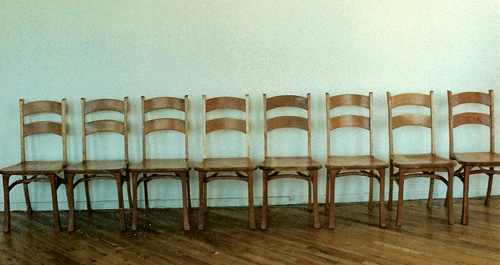
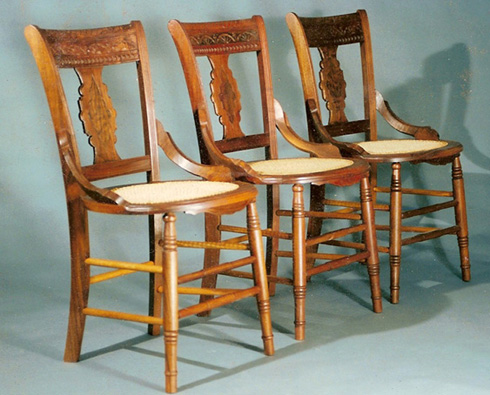
---------------------------------------------------------
My old wire chair has the unique quality of blending in, nearly invisible in a natural landscape, when not covered with snow, yet ready to do service for extended phone conversations, or for rare moments of doing nothing at all. A chair more nothing than something.
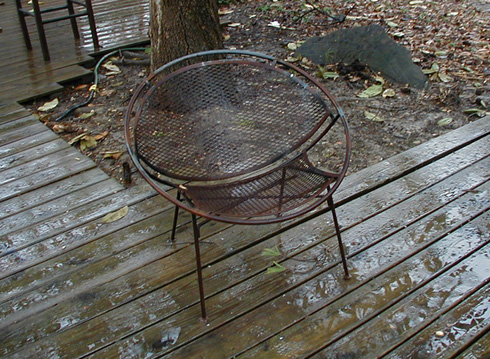
As the aesthetic of wabi sabi is greater than a simple description, the making of a chair requires making more than ten to really get it right. I make no claims.
-----------------------------------------------------------------
My wife, whom I refer to as Blondie when writing about her, picked up the little wire table shown above with the metal chair. Another gift of trash night. It is in phase three of repairs. The vertical wires forming the leg had broken away from the one-inch steel balls they were welded to. My first fix was to wire them together. When the weather breaks, there is usually a flurry of yardening and fixing around here; one year I stepped up from wire to a stainless steel hose clamp. Last year, I acquired a acetylene welding torch. I think the little table will go on for awhile with the third level of welded repairs. It is rusting nicely. The glass top, under the pancake of snow in the photo, is a perfect fit; a gift from an uncle “who art in heaven” as my octogenarian friend John refers to his beloved departed.
-------------------------------------------------------------------
The wood lathe was probably used in a local high school fifty years ago. The used-machine guy I bought it from has connections with local governments. It is stoutly and simply made, mid-level quality, and came with many accessories, including a small section of the base, a key part. By rigging up that attachment you can make the lathe any length.
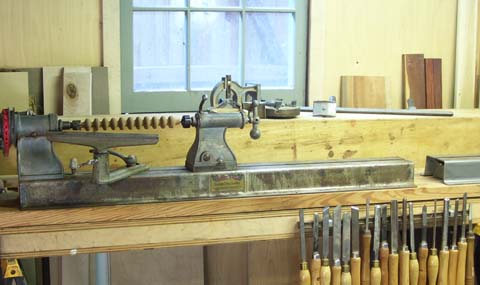
I used it to turn these roller clamps for the Freer Gallery. Japanese scroll paintings are traditionally stored using these devices made of paulownia wood. I made several, including one six feet long using my wabi sabi lathe.
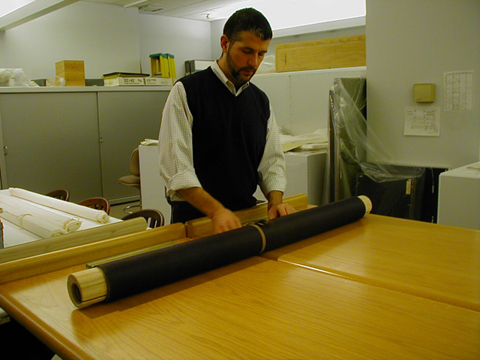 This is Andrew, the Freer’s conservator, a few years ago, testing his new clamp.
This is Andrew, the Freer’s conservator, a few years ago, testing his new clamp.
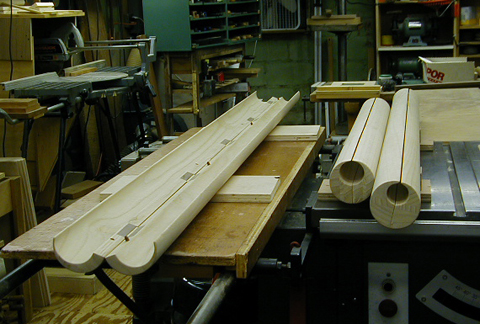 And, in my shop, some others, including the longest.
And, in my shop, some others, including the longest.
I used the lathe to turn the legs on the walnut chairs shown above.
-------------------------------------------------------------------
However, I don’t think the concept of wabi sabi is going to cover electronic consumer products. And, I am a fan of those.
I have had cordless phones since they came on the market in the early 80’s. Most memorable is one from about the second generation of those things, years ago. The handset was about as big as a one pound box of spaghetti. After months of use it started to drop calls due to weak signals and weak batteries. It finally got my blood up, and I set it on our brick patio and murdered the base station and the spaghetti box, cutting the two into four pieces with two measured blows of my four pound ax. For three weeks I picked up non-mulching bits of circuit board, plastic, and wire out of the surrounding grass.
And that brings me to the Arabian Nights. Like most people, I was familiar with the Arabian Nights but never read the book. A scene in the 1987 French film Au Revoir Le Enfants got me interested. The film is set in Nazi-occupied France at a boys school and, one night, the boys are huddled in their dormitory, one is reading aloud juicy passages from the Arabian Nights. The film is in French so in the subtitles the boy read: “Truly, she combined the lascivious movements of Arab girls with the consummate science of the Indians, the coquetry of the women of Yemen..” then the scene changed. Wait. Stop. Back up the Tivo. What a great line. What’s the name of that story? Where’s my passport?
With a little internet research I discovered the translation the boys were probably reading was that of Sir Richard Francis Burton, an English scholar. He translated and published a sixteen volume set of the middle eastern folk tales in the late 1800’s.
Here is a link to all 16 volumes. Somewhere in those nearly 6000 pages is that quote. I’m still looking for it. I mention this in the hope that if any of you read some of Burton’s no-holds-barred translations and find it, that you will relay your discovery to me.
http://burtoniana.org/books/1885-Arabian%20Nights/index.htm
If nothing else, I encourage you to read the first few pages of volume one leading up to the introduction of Scheherazade and the beginning of the Thousand and One Nights.
This translation is for adults only. Burton, a bad-boy, prep-school Brit is irreverent, bawdy, and racist by today’s standards, and therefore vastly more entertaining than the milder translations made for more genteel readers. Oh, he was translating the Kama Sutra at the same time.
In the section I have advised you to look at, a king sets out on a journey to see his brother, another king, who is faraway; he leaves his wife behind. The caravan takes so long to get itself together that by the end of the first day’s journey, the group camps for the night still within sight of the castle. The king remembers he forgot something, and returns to his castle to find his wife in the arms of his cook. Enraged “He drew his scimitar and cutting the two in four pieces with a single blow, left them on the carpet and returned presently to his camp……” That wonderful mathematical sentence reminded me of the demise of my second generation cordless phone.
I am presently in search of a scimitar which I plan to have on hand for the next time my aging pc laptop shows me a blue screen filled with indecipherable computer code.
------------------------------------------------------------------- Friday, March 6, 2009, Temperature 68 degrees: Today, typical of the weather in the national capital area, the snow of Monday has returned to nothing.
Winter coats are out of sight. My chair has receded into the back ground, the threatened laptop is stable…. and, a note of caution: the stunt with the ax was performed by a skilled craftsman and is not intended for replication by those without proper training.
All disgarded consumer electronic devices and their batteries should be recycled; most easily through retailers like Radio Shack, Wall Mart, or Office Depot.
--------------------------------------------------------------
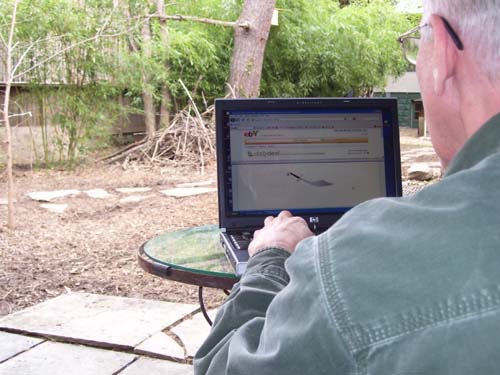
--------------------------------------------------------------
links: The Brass Knob http://earth911.com/
http://www.criterion.com/films/549
Posted by ronpaci at March 8, 2009 2:32 PM